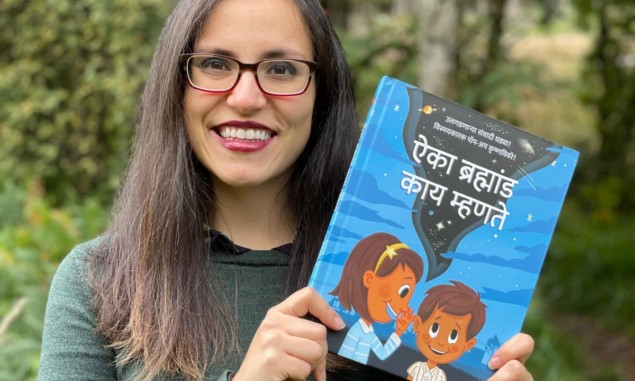Music inspired by black holes, book encourages children to listen to the universe
17 Sep 2021 Hamish Johnston
Have you ever wondered what a black hole “sounds” like? The Belgian mathematician, lecturer, and electronic musician Valery Vermeulen has created an album of electronic music that was composed using data associated with black holes. Collaborating with the cosmologist Thomas Hertog and physicist Matthias Kaminski, Vermeulen selected data from simulation models of astrophysical black holes as well as gravitational-wave observations of the objects.
According to the composer’s studio, Vermeulen has bridged the fields of mathematics and music by designing, “bespoke data sonification systems to create otherworldly expansive soundscapes, that guide us into the higher dimensional realms of deep space and reality”.
The album is called Mikromedas AdS/CFT 001 and it will be released by the London based record label Ash International in December 2021. You can listen to a preview of the album here.
Pop-up book
Vermeulen is not the only person listening to black holes. The physicist Mariela Massó Reid and children’s literature expert Dimitra Fimi – both at the University of Glasgow – have teamed up to write a pop-up book called Listen to the Universe.
Aimed at children in Hingoli district of Maharashtra in western India, the book is a conversation between a girl and boy (Lila and Gopu) about the LIGO gravitational-wave detector that is planned for the area. In the book, Lila explains gravitational waves to Gopu, starting with Einstein’s suggestion of their existence in 1915.
“We were incredibly excited when formal approval for the building of LIGO–India came from the Indian Prime Minister in 2016,” says Massó Reid. “However, we were also very conscious that a large observatory was going to be built close to many rural communities. Our initial aim was to introduce and explain the purpose of these large instruments to local people.”
Massó Reid adds that the authors aimed their book at young children “to inspire girls and boys to realize that they can be anything they want – and that girls can be astrophysicists”. They also hope that parents will read the book along with their children and learn about LIGO–India.
The book is illustrated by British illustrator Oliver Dean. It is written in Marathi, the language of the region, and was written in consultation with scientists working on LIGO–India. 1000 copies of the book have been printed initially and there are plans for translations into other languages.
FROM PHYSICSWORLD.COM 17/9/2021

Δεν υπάρχουν σχόλια:
Δημοσίευση σχολίου